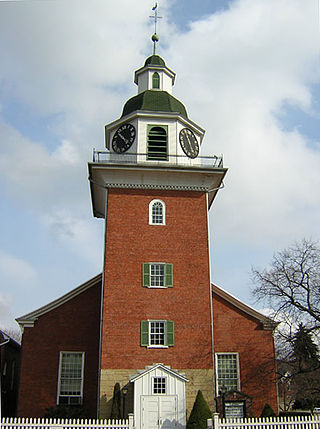Related Research Articles

The Harmony Society was a Christian theosophy and pietist society founded in Iptingen, Germany, in 1785. Due to religious persecution by the Lutheran Church and the government in Württemberg, the group moved to the United States, where representatives initially purchased land in Butler County, Pennsylvania. On February 15, 1805, the group of approximately 400 followers formally organized the Harmony Society, placing all their goods in common.

The Oneida Community was a perfectionist religious communal society founded by John Humphrey Noyes and his followers in 1848 near Oneida, New York. The community believed that Jesus had already returned in AD 70, making it possible for them to bring about Jesus's millennial kingdom themselves, and be perfect and free of sin in this world, not just in Heaven. The Oneida Community practiced communalism, group marriage, male sexual continence, Oneida stirpiculture, and mutual criticism.

An intentional community is a voluntary residential community which is designed to have a high degree of social cohesion and teamwork. The members of an intentional community typically hold a common social, political, religious, or spiritual vision, and typically share responsibilities and property. This way of life is sometimes characterized as an "alternative lifestyle". Intentional communities can be seen as social experiments or communal experiments. The multitude of intentional communities includes collective households, cohousing communities, coliving, ecovillages, monasteries, survivalist retreats, kibbutzim, Hutterites, ashrams, and housing cooperatives.

John George Rapp was the founder of the religious sect called the Harmony Society and a number of associated communes.

Utopia is an unincorporated community in far southern Franklin Township, Clermont County, Ohio, United States, along the banks of the Ohio River. Utopia has been referred to as a "ghost town" although there are still people who live there.

Mitcheltree Township is one of six townships in Martin County, Indiana, United States. As of the 2020 census, its population was 571 and it contained 313 housing units.

Spice Valley Township is one of nine townships in Lawrence County, Indiana, United States. As of the 2010 census, its population was 2,423 and it contained 1,137 housing units.

Raglesville is an unincorporated community and census-designated place (CDP) in Van Buren Township, Daviess County, Indiana, United States. As of the 2010 census it had a population of 141.

Cheltenham is a neighborhood of St. Louis, Missouri. It is bound by Forest Park on the north, Macklind on the east, Manchester Avenue on the south, and Hampton Avenue on the west. Businesses located in Cheltenham include the St. Louis Community College at Forest Park, which is built on the site of the former Forest Park Highlands amusement park, as well as The Green Shag Market vintage/antique mall. It is also the former home of FOX-affiliate KTVI, as well as the St. Louis Arena. Cheltenham once covered the Clayton-Tamm neighborhood. See the 1878 Cheltenham and Additions map.
Diggers and Dreamers is a group that promotes intentional communities in England, Scotland, Wales and Northern Ireland.

Silkville is a ghost town in Williamsburg Township, Franklin County, Kansas, United States. It was located approximately 2 miles southwest of Williamsburg at the intersection of U.S. 50 highway and Arkansas Road.
Moberly is an unincorporated community in Spencer Township, Harrison County, Indiana, in the United States.
Huffman is an unincorporated community in Harrison Township, Spencer County, in the U.S. state of Indiana.
Maxville is an unincorporated community in Huff Township, Spencer County, in the U.S. state of Indiana.
Phalanx is an unincorporated community in Braceville Township, Trumbull County, Ohio, United States. It is identified by signage as Phalanx Mills.

Haleysburg is an unincorporated community in Jefferson Township, Washington County, in the U.S. state of Indiana.

McKinley is an unincorporated community in Jefferson Township, Washington County, in the U.S. state of Indiana.

Prowsville is an unincorporated community in Jefferson Township, Washington County, in the U.S. state of Indiana.

Farabee is an unincorporated community in Pierce Township, Washington County, in the U.S. state of Indiana.
The Sunrise Cooperative Farm Community, also known as the Sunrise Colony, was a communal living experiment founded by Jewish anarchists on 10,000 acres of farmland near Saginaw, Michigan, between 1933 and 1936, during the Great Depression.
References
- ↑ Sutton, Robert P. (2003). Communal utopias and the American experience: religious communities, 1732-2000. Westport, Connecticut, United States: Praeger Publishers. pp. 164 and following. ISBN 0-275-97554-1.
- ↑ Melton, J. Gordon (2009). Melton's encyclopedia of American religions (8th ed.). Detroit: Gale Cengage Learning. p. 681. ISBN 978-0-787-69696-2.
- ↑ Kenning, Chris. "Utopia evolved: How Indiana commune survived". The Courier-Journal. Retrieved January 9, 2022.
